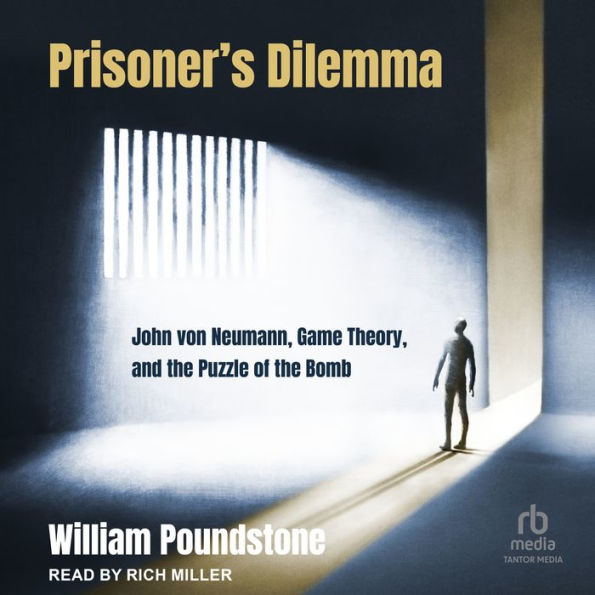Poundstone's three-dimensional outline of game theory mathematics sketches the life of its inventor, John von Neumann, and his role in Cold War policy-making. Photos. (Feb.)
Should you watch public television without pledging? Exceed the posted speed limit? Hop a subway turnstile without paying? These questions illustrate the "prisoner's dilemma", a social puzzle that we all face every day. Though the answers may seem simple, their profound implications make the prisoner's dilemma one of the great unifying concepts of science. Watching poker players bluff inspired John von Neumann to construct game theory, a mathematical study of conflict and deception. Game theory was readily embraced at the RAND Corporation, the archetypical think tank charged with formulating military strategy for the atomic age, and in 1950 two RAND scientists made a momentous discovery.
Called the "prisoner's dilemma," it is a disturbing and mind-bending game where two or more people may betray the common good for individual gain. The prisoner's dilemma quickly became a popular allegory of the nuclear arms race. Intellectuals such as von Neumann joined military and political leaders in rallying to the "preventive war" movement, which advocated a nuclear first strike against the Soviet Union. Though the Truman administration rejected preventive war the US entered into an arms race with the Soviets and game theory developed into a controversial tool of public policy-alternately accused of justifying arms races and touted as the only hope of preventing them.
"1113250441"
Called the "prisoner's dilemma," it is a disturbing and mind-bending game where two or more people may betray the common good for individual gain. The prisoner's dilemma quickly became a popular allegory of the nuclear arms race. Intellectuals such as von Neumann joined military and political leaders in rallying to the "preventive war" movement, which advocated a nuclear first strike against the Soviet Union. Though the Truman administration rejected preventive war the US entered into an arms race with the Soviets and game theory developed into a controversial tool of public policy-alternately accused of justifying arms races and touted as the only hope of preventing them.
Prisoner's Dilemma: John von Neumann, Game Theory, and the Puzzle of the Bomb
Should you watch public television without pledging? Exceed the posted speed limit? Hop a subway turnstile without paying? These questions illustrate the "prisoner's dilemma", a social puzzle that we all face every day. Though the answers may seem simple, their profound implications make the prisoner's dilemma one of the great unifying concepts of science. Watching poker players bluff inspired John von Neumann to construct game theory, a mathematical study of conflict and deception. Game theory was readily embraced at the RAND Corporation, the archetypical think tank charged with formulating military strategy for the atomic age, and in 1950 two RAND scientists made a momentous discovery.
Called the "prisoner's dilemma," it is a disturbing and mind-bending game where two or more people may betray the common good for individual gain. The prisoner's dilemma quickly became a popular allegory of the nuclear arms race. Intellectuals such as von Neumann joined military and political leaders in rallying to the "preventive war" movement, which advocated a nuclear first strike against the Soviet Union. Though the Truman administration rejected preventive war the US entered into an arms race with the Soviets and game theory developed into a controversial tool of public policy-alternately accused of justifying arms races and touted as the only hope of preventing them.
Called the "prisoner's dilemma," it is a disturbing and mind-bending game where two or more people may betray the common good for individual gain. The prisoner's dilemma quickly became a popular allegory of the nuclear arms race. Intellectuals such as von Neumann joined military and political leaders in rallying to the "preventive war" movement, which advocated a nuclear first strike against the Soviet Union. Though the Truman administration rejected preventive war the US entered into an arms race with the Soviets and game theory developed into a controversial tool of public policy-alternately accused of justifying arms races and touted as the only hope of preventing them.
24.99
In Stock
5
1

Prisoner's Dilemma: John von Neumann, Game Theory, and the Puzzle of the Bomb

Prisoner's Dilemma: John von Neumann, Game Theory, and the Puzzle of the Bomb
FREE
with a B&N Audiobooks Subscription
Or Pay
$24.99
24.99
In Stock

Editorial Reviews
Product Details
| BN ID: | 2940159384324 |
|---|---|
| Publisher: | Tantor Audio |
| Publication date: | 12/26/2023 |
| Edition description: | Unabridged |
Videos

From the B&N Reads Blog
